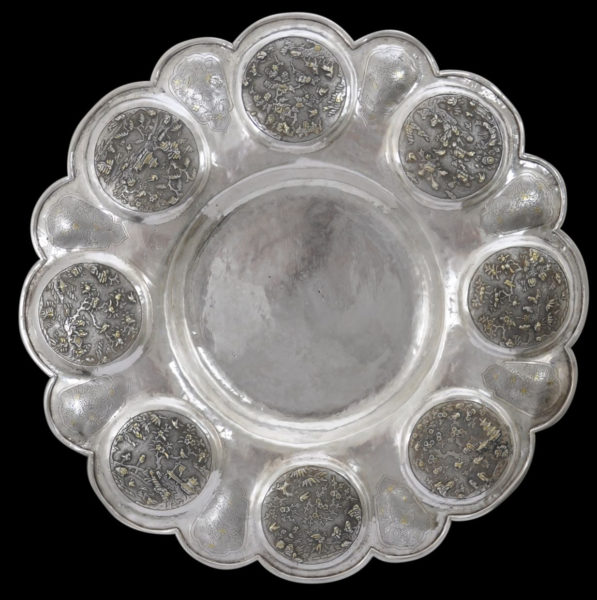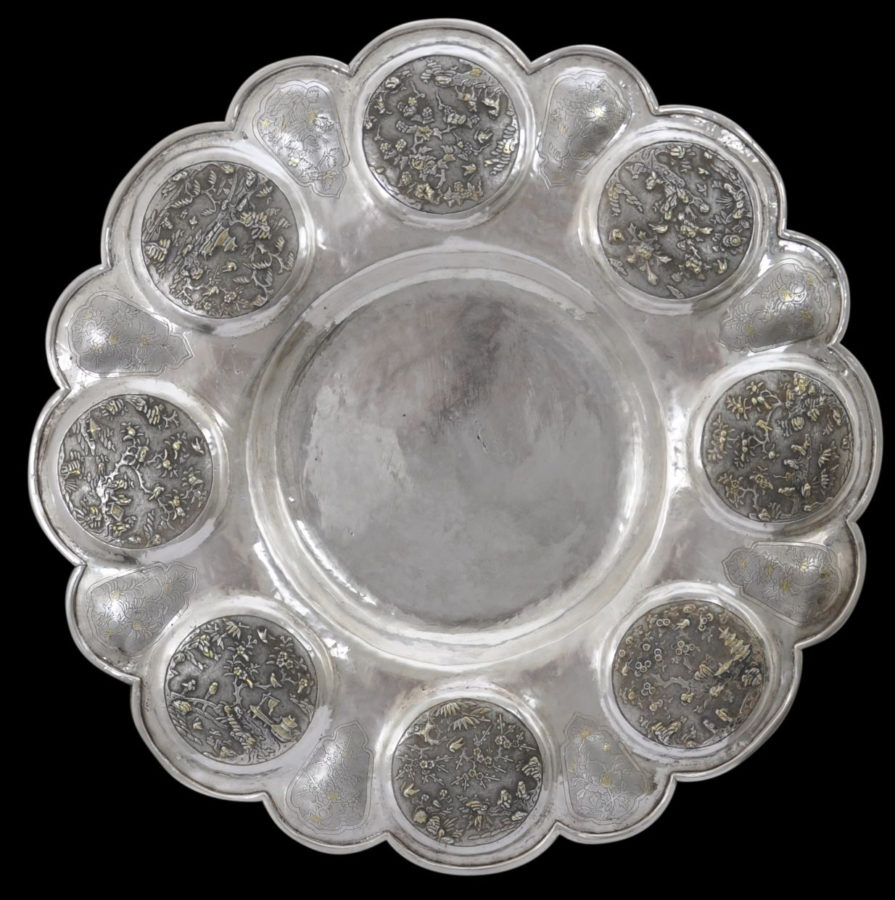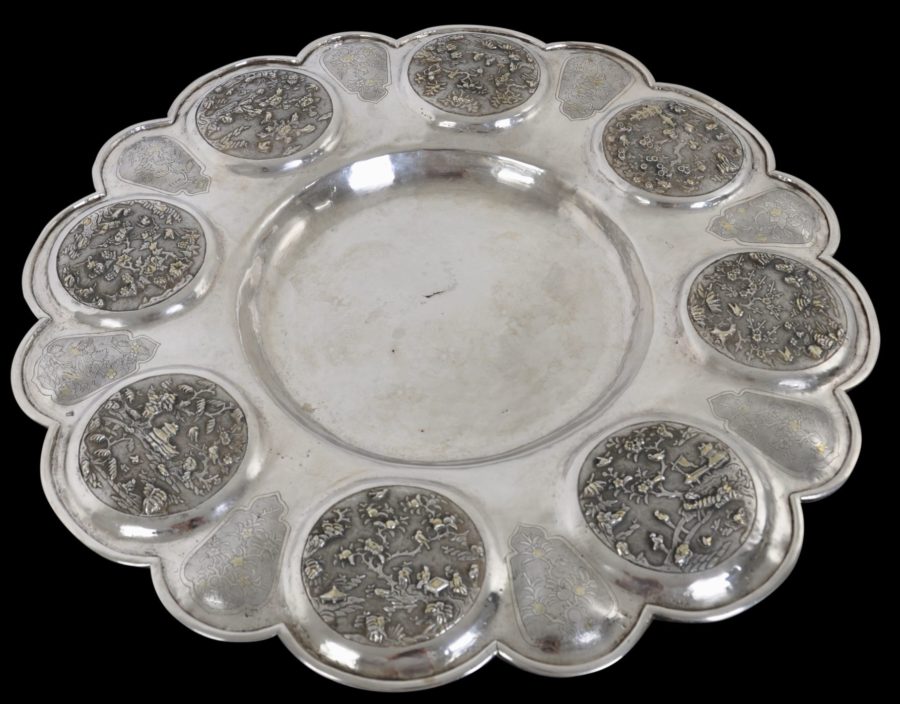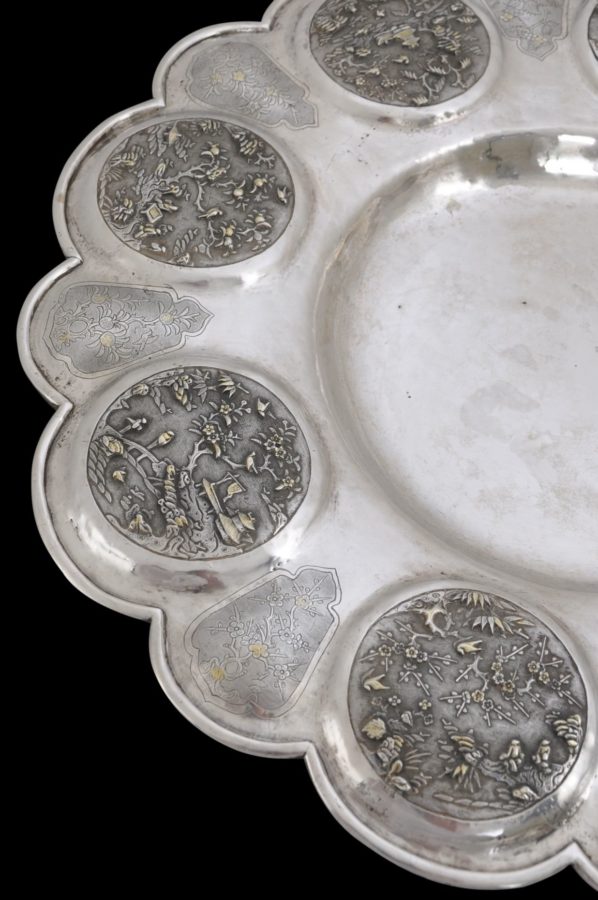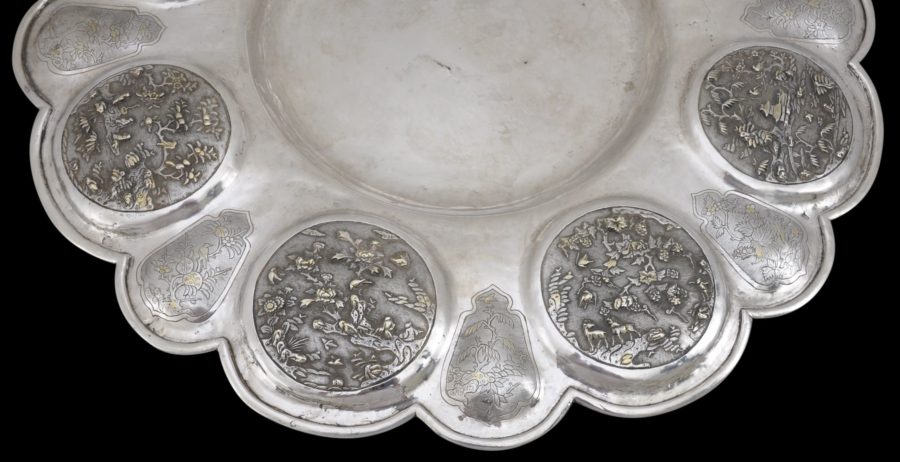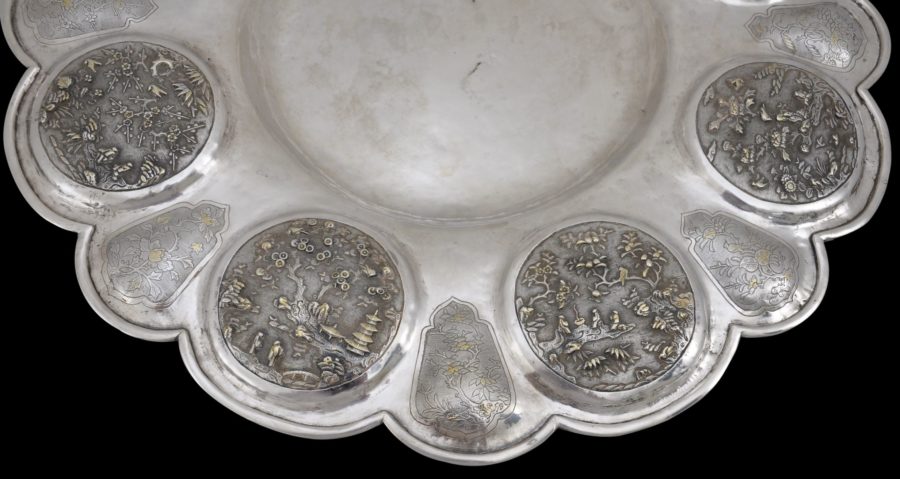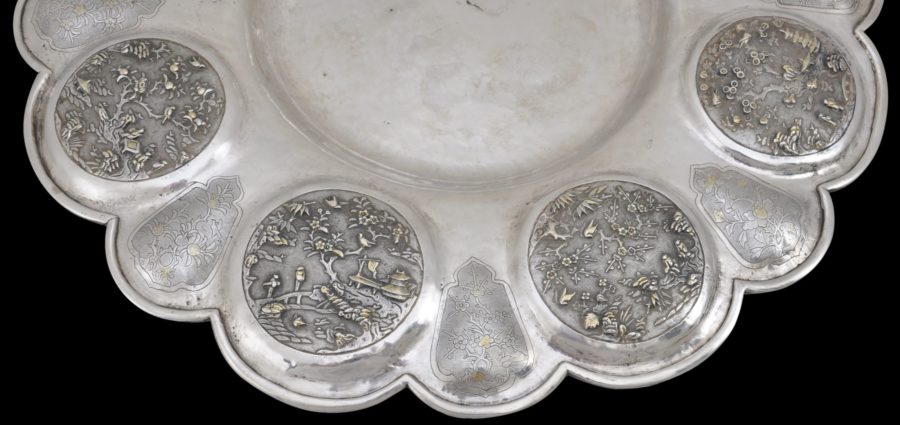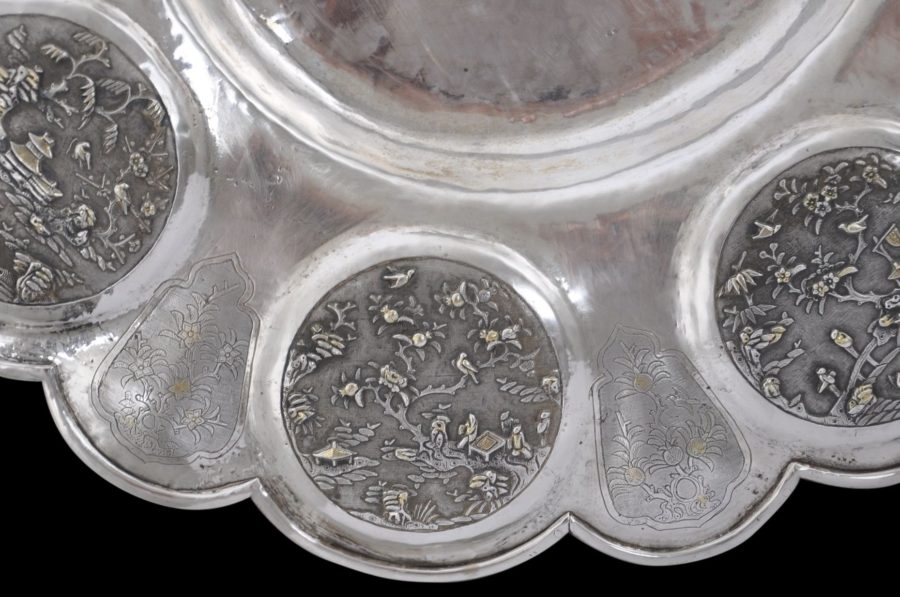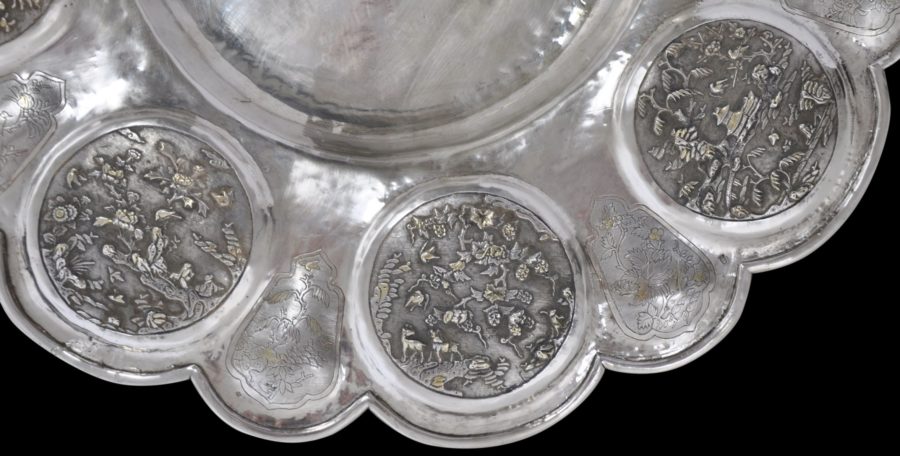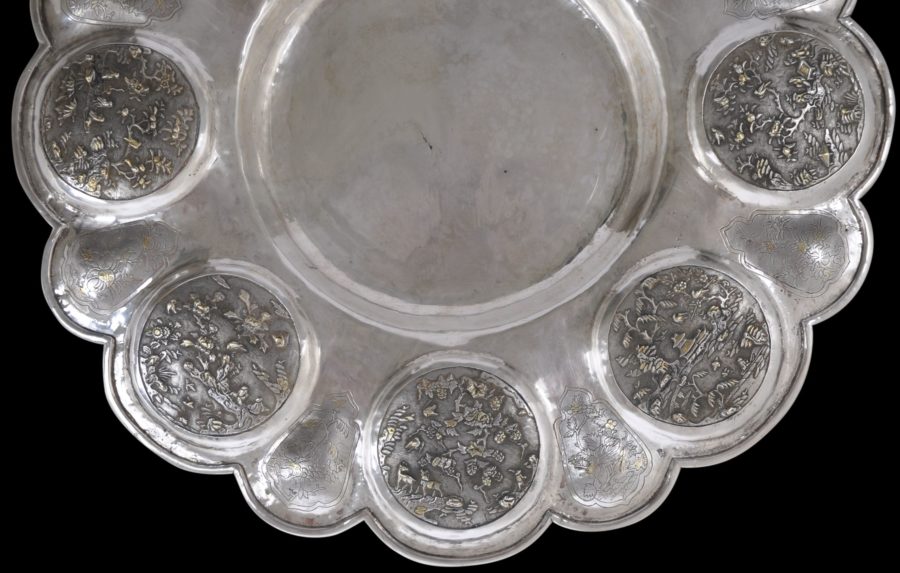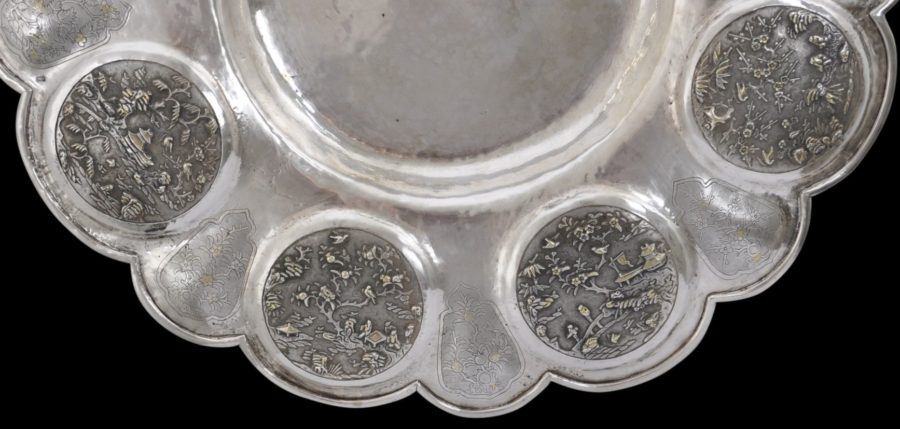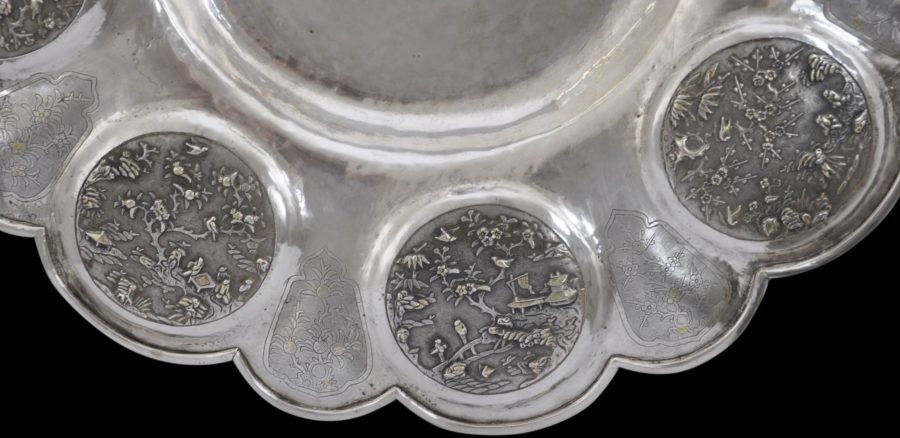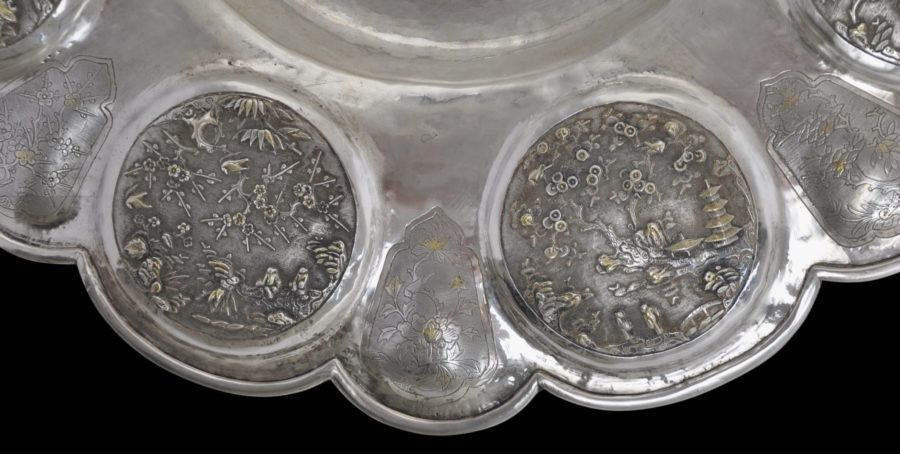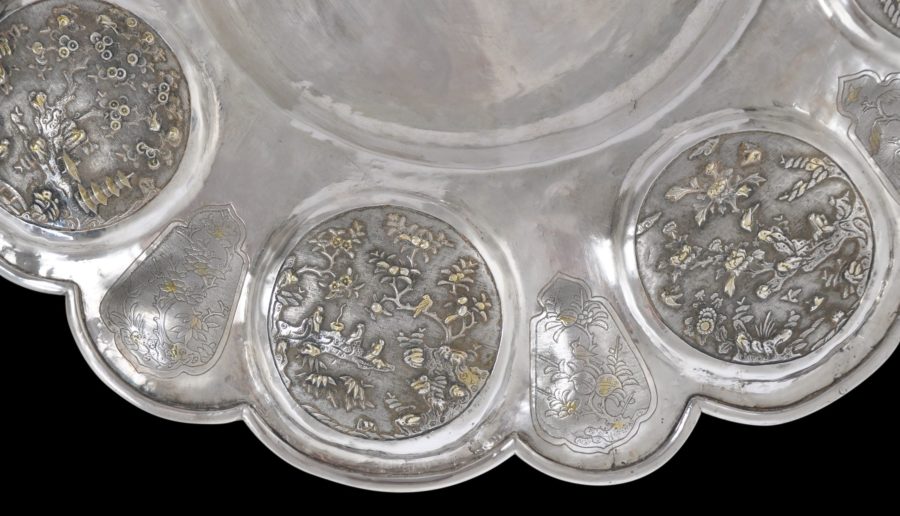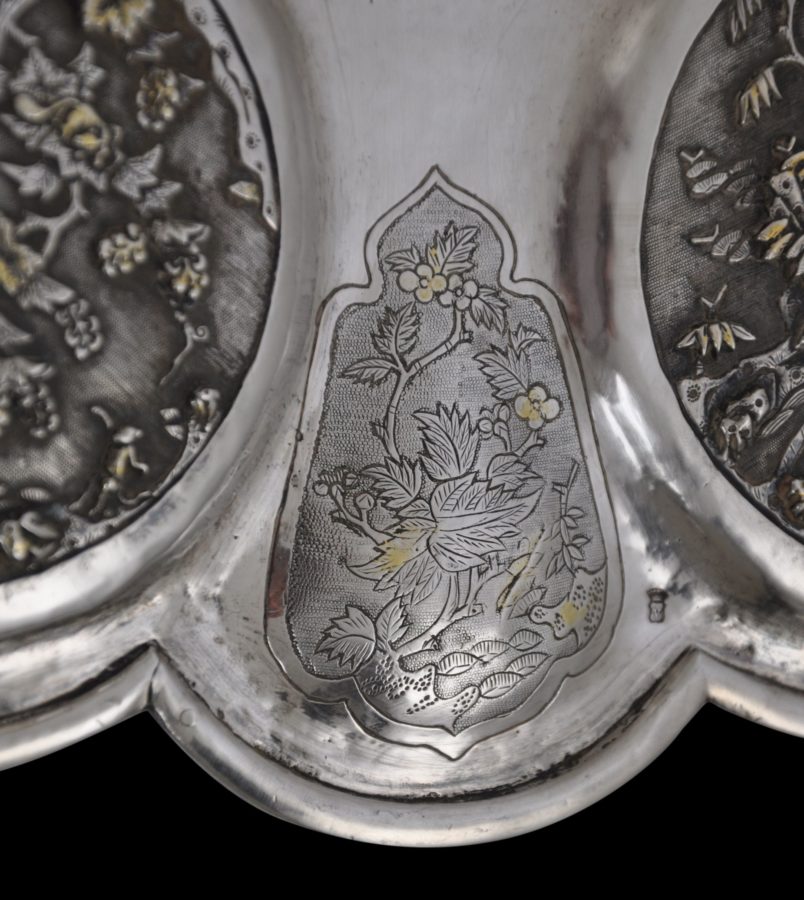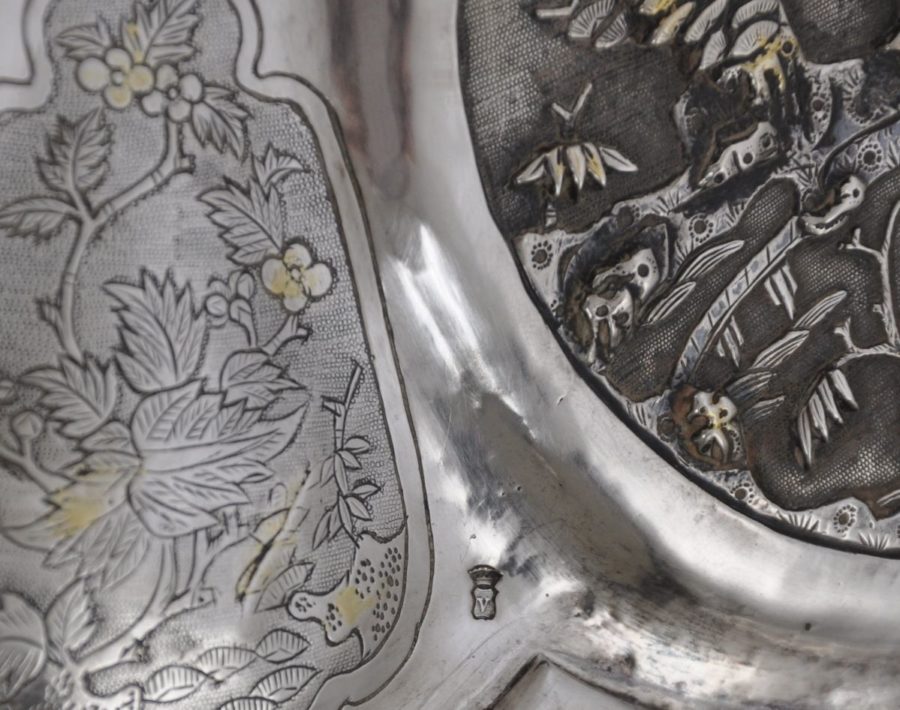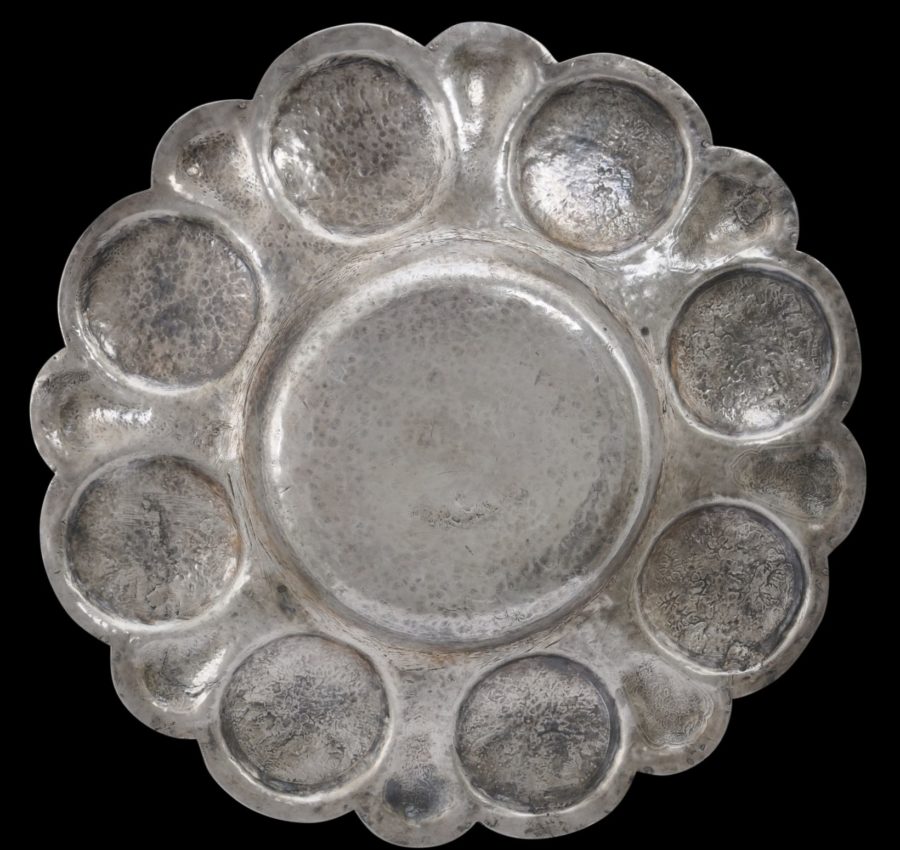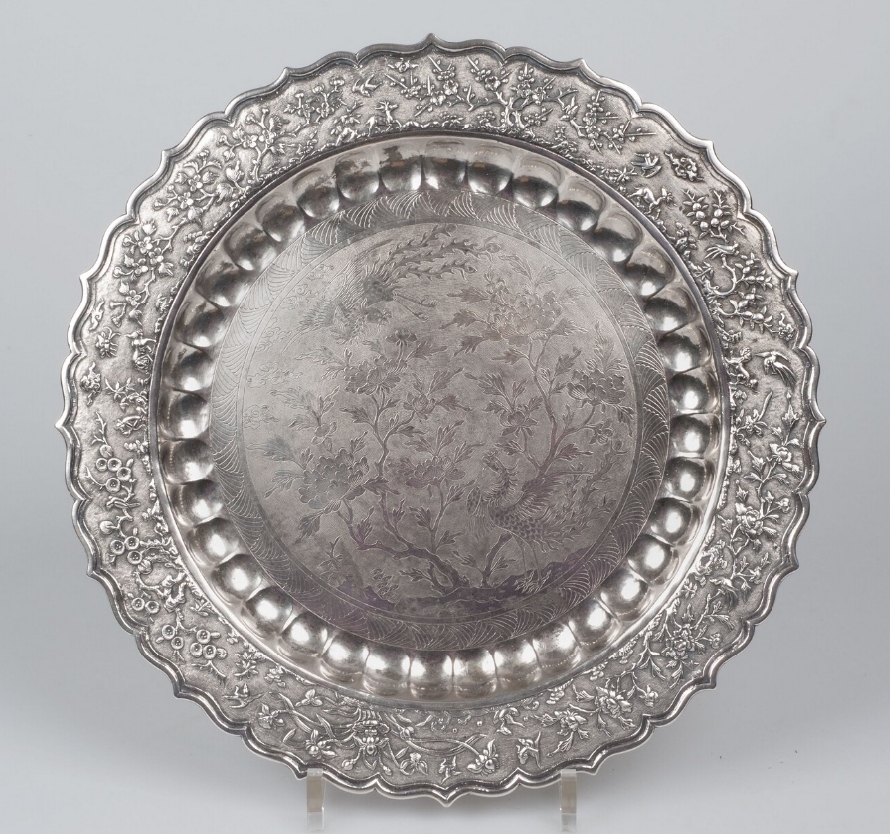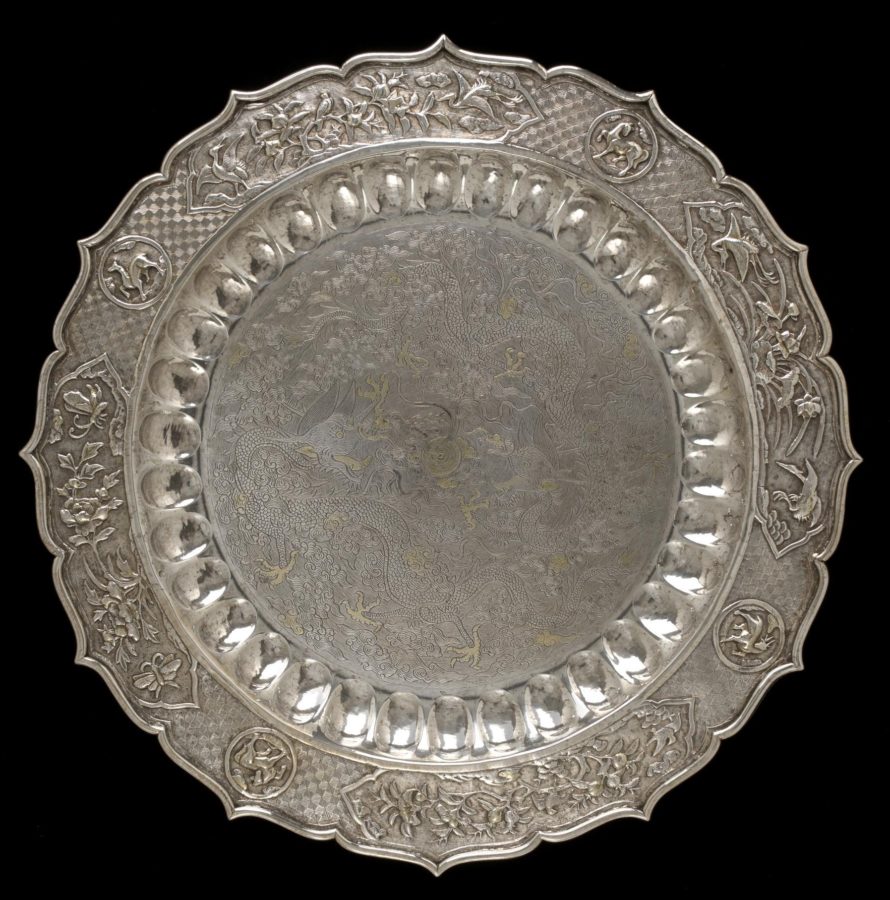This large, monumental platter or salver has been made in a form favoured in 17th century Holland. Such large silver platters often were used in Dutch and Dutch colonial churches as baptismal fonts. The motifs used on it are Chinese and it is likely that the platter is the product of Chinese silversmiths operating in Batavia in the Dutch East Indies on behalf of the VOC in the late 17th century. Importantly, the platter has a Dutch assay mark for foreign-made silver, further attesting to its Dutch colonial provenance. Two other salvers are known which are of similar size and with similar construction although they are likely to be slightly later. One was the property of Tipu Sultan, and the other, with Batavia assay marks is in a museum collection in the Netherlands.
The platter here is of high-grade, solid silver with parcel-gilding. It is almost half a metre across and weighs more than two kilograms. It comprises a plain interior and a wide, scalloped rim of eight raised roundels decorated with Chinese motifs and scenes in high relief against a very finely tooled background, interspersed with engraved, tear-shaped cartouches decorated with peonies, willow and other Chinese-style flowers and plants, also against a tooled ground. The details of the roundels and cartouches have been parcel-gilded. The outer edge of the rim has been reinforced with raised edging that has been riveted on with fine silver rivets.
The form of a wide platter with with its eight lobed, raised cartouches around the rim is very much in keeping with late-17th century Dutch and colonial Dutch tastes. A platter, formerly in a deceased Batavian estate in this form is illustrated in Zandvliet (2002, p, 224). Others are illustrated in Voskuil-Groenewegen (1998, p. 89) and Eliens (2012, p. 74 & p. 85).
As mentioned, often platters of this size were used in colonial Dutch churches, sometimes as baptismal fonts, as illustrated in Veenendaal (2014, p. 112) in respect of a large, 17th century colonial silver salver used in the Wolvendaal Church, Colombo, Sri Lanka.
The manner of the platter’s construction is interesting. The detail of each main panel is not the result of chasing or repousse-work, but rather each tiny bird, pagoda or other detail has been constructed separately and then carefully soldered on. Then, these raised highlights were gilded – but not fire gilded as is the usual practice seen on most extant examples of silver. Instead, thin gold sheet was hammered carefully over each raised element. These techniques are early and help to support an earlier dating for the platter.
The platter is part of a small group of similar items in silver that are likely to have been made by identifiably ethnic Chinese silversmith in Batavia in the Dutch East Indies on behalf of the Dutch East India Company or the Vereenigde Oostindische Compagnie (VOC).
We have been able to locate just two other known, related examples of platters or salvers.
All three have similarly large sizes (although ours is the largest); similar, early construction techniques; Chinese-style engraving; decorative Chinese motifs and scenes in high relief; and parcel gilding. Our example however, is likely to be slightly earlier than the other two.
One example is in the National Museum of World Cultures (Tropenmuseum) in the Netherlands. This example is important. Chinese in design and motif, ordinarily, it would be thought to be from China, but it is stamped on the reverse with several assay marks that reveal that it is in fact VOC silver. The marks are clear and are assay town marks for Batavia as well as some maker’s marks. (Only silver with a maker’s mark was tested and received an assay mark.) The platter is thought to date to 1713. (See the second-to-last image below for this platter.)
The other platter is in London’s Victoria & Albert Museum and was seized from the grounds of Tipu Sultan’s palace in the aftermath of the siege of Seringapatam in 1799, when British forces laid waste to the palace of the then ruler of the Kingdom of Mysore in south India. (See the final image below for this example.) This example is listed in the V&A’s inventory as being from China, but that is a supposition only, and judging from the Netherlands example, an imprecise one. Almost certainly, the Tipu Sultan platter is VOC silver from Batavia (as in fact are several items of silver from Tipu Sultan’s palace – probably they were gifts from the VOC.)
Early photographs of other similar VOC silver platters that were in the Hervormde Kerke (Church) in Depok (Java) are in collection of the Royal Netherlands Institute of Southeast Asian and Caribbean Studies (KITLV). The whereabouts of these platters no longer is known and in all probability they were melted for their silver content.
Our example does not have a maker’s mark (and hence no town assay mark for Batavia) but it does have a Dutch assay mark of a type used from 1814 for large objects of foreign-made silver consisting of at least 833 silver parts per 1,000. (Our platter tests for much higher than that.) The fact that it has a Dutch control mark for foreign silver is important as it further underscores the probability that the platter is Batavian. Also, the mark is not an import mark as such but a control mark so that the platter could be sold legally as silver in the Netherlands. It might have arrived into the Netherlands prior to 1814.
Another item of silver that is VOC and Batavian but is in a Chinese style is illustrated in van Campen & Hartkamp-Jonxis (2011, p. 63).
The work on our platter, particularly the method of silver applique as well as the gilding and motifs are reminiscent of a silver spouted ewer or kendi in the collection of Singapore’s Asian Civilisations Museum (ACM). The kendi is dated variously as circa 1680-1700 or early 18th century, and is described as having been made in China for the Southeast Asian market (Lingner & Onn, 2017, p. 33). It is more likely however, that it was made by Chinese silversmiths probably in Batavia for the local market. Kendis were, after all, used almost exclusively by Muslims in the Dutch East Indies.
A small silver teapot believed to be from China and with British import marks for 1682 and illustrated in Krohn & Miller (2009, p, 247) also has similar applied silverwork in high relief (as opposed to repousse or chasing work). It is now recognised as the earliest documented example of Chinese silver exported to Europe. The teapot is obviously the work of Chinese silversmiths, but whether they were in China or elsewhere in Asia is a separate matter.
Interestingly, the high-relief motifs on the platter here and the ACM kendi are reminiscent of that on sawasa work done for the VOC in the 17th and 18th centuries. Sawasa items were made from an alloy of copper with gold, silver and arsenic which were then finished with a surface decoration of black lacquer and mercury fire gilding (gold plating).
Most sawasa items are believed to have been produced in Japan according to Dutch specifications in the 17th and 18th centuries. It is also possible that sawasa items also were commissioned by the Dutch from artisans in (or near) Batavia or from Tonkin (what is now northern Vietnam).
VOC colonial Dutch silver from Batavia intended for use by Europeans is quite rare. Veenendaal (2014, p. 101) makes the point that towards the end of the VOC’s rule in Batavia and following its bankruptcy, conditions for the European and Eurasian residents of Batavia became harsh and impoverished. Much of the silverware belonging to the European population was requisitioned to mint coinage and undoubtedly to help pay off VOC debts. Silver held by churches and in indigenous hands survived and this has become the source of much of what has survived today. Veenendaal describes much of the Batavian silver as having ‘originally Dutch style, but with Chinese motifs’. The platter here clearly is in that vein.
The platter is in fine condition. There are losses to the gilding, as might be expected given its age. There is a small flake to the interior base of the bowl due to the purity of the silver. But overall, the platter is monumental, important, and of significant museum quality.
Reminder: The final two images below show related (but probably slightly later) silver platters in the Tropenmuseum and the V&A respectively.
References
Brinkgreve, F., & J. Leijfeldt, ‘The Chinese-Indonesian collection in the National Museum of World Cultures, the Netherlands’, Wacana, Vol. 18, No. 2. 2017.
de Bruijn, M., et al, Sawasa: Japanese Export Art in Black and Gold, 1650-1800, Rijksmuseum/Waanders Publishers, 1998.
van Campen, J., & E. Hartkamp-Jonxis, Asian Splendour: Company Art in the Rijksmuseum, Walburg Pers, 2011.
Eliens, T.M., Silver from Batavia/Zilver uit Batavia, Gemeentemuseum Den Haag/W Books, 2012.
Frederiks, J.W., Dutch Silver: Embossed Plaquettes, Tazze and Dishes from the Renaissance until the end of the Eighteenth Century, Martinus Nijhoff, 1952.
Krohn D.L. & P.N. Miller (eds.), Dutch New York Between East and West: The World of Margrieta van Varick, Bard Graduate Center/The New York Historical Society/Yale University Press, 2009.
Lingner, R., & C. Onn, ACM Treasures: Collection Highlights, Asian Civilisations Museum, 2017.
Veenendaal, J., Asian Art and the Dutch Taste, Waanders Uitgevers Zwolle, 2014.
Voskuil-Groenewegen, S.M., V.O.C. – Zilver: Zilver uit de Periode de Verenigde Oostindische Compagnie, 17de en 18de eeuw, Gemeentemuseum, Den Haag, 1983.
Voskuil-Groenewegen, S.M. et al, Zilver uit de tijd van de Verenigde Oostindische Compagnie, Waanders Uitgevers, 1998.
Zandvliet, K. et al, The Dutch Encounter with Asia 1600-1950, Rijksmuseum Amsterdam, 2002.


